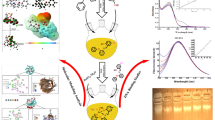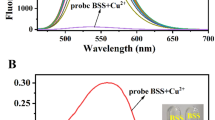Abstract
The interaction of 2-(2′-hydroxyphenyl)benzimidazole (HPBI) and its nitrogen substituted analogues 2-(2′-hydroxyphenyl)-3H-imidazo[4,5-b]pyridine (HPIP-b) and 2-(2′-hydroxyphenyl)-1H-imidazo-[4,5-c]pyridine (HPIP-c) with BSA was explored. Upon interaction with BSA both normal and tautomer emissions are significantly enhanced. However, the fluorescence ratios of the normal band to the tautomer band of HPBI and HPIP-b decrease, but that of HPIP-c increases. From the tautomer emission, the stoichiometry and association constants were determined. HPBI exists as cis- and trans-enolic and zwitterionic forms, whereas HPIP-b and HPIP-c are present as monoanions in addition to cis- and trans-enols. The study shows that different conformers of all three molecules bind at different binding sites of BSA.
Similar content being viewed by others
References
A. A. Waheed, K. S. Rao and P. D. Gupta, Mechanism of dye binding in the protein assay using eosin dyes, Anal. Biochem., 2000, 287, 73–79.
X. M. He and D. C. Carter, Atomic-structure and chemistry of human serum-albumin, Nature, 1992, 358, 209–215.
U. Kragh-Hansen, Molecular aspects of ligand binding to serum albumin, Pharmacol. Rev., 1981, 33, 17–53.
F. Karush, Heterogeneity of the binding sites of bovine serum albumin, J. Am. Chem. Soc., 1950, 72, 2705–2713.
P. Bourassa, C. D. Kanakis, P. Tarantilis, M. G. Pollissiou and H. A. Tajmir-Riahi, Resveratrol, genistein, and curcumin bind bovine serum albumin, J. Phys. Chem. B, 2010, 114, 3348–3354.
F.-L. Cui, J. Fan, J.-P. Lib, Z.-D. Hua, Interactions between 1-benzoyl-4-p-chlorophenyl thiosemicarbazide and serum albumin: Investigation by fluorescence spectroscopy, Bioorg. Med. Chem., 2004, 12, 151–157.
V. S. Jisha, K. T. Arun, M. Hariharan and D. Ramaiah, Site-selective binding and dual mode recognition of serum albumin by a squaraine dye, J. Am. Chem. Soc., 2006, 128, 6024–6025.
G. Sudlow, D. J. Birkett and D. N. Wade, Futher characterization of specifc drug binding-sites on human-serum albumin, Mol. Pharmacol., 1976, 12, 1052–1061.
J. R. Lakowicz, Principles of Fluorescence Spectroscopy, Springer, New York, 3rd edn, 2006.
A. J. Ozinskas, Principles of Fluorescence Immunoassay, in Topics in Fluorescence Spectroscopy, Volume 4–Probe Design and Chemical Sensing, ed. J. R. Lakowicz, Plenum Press, New York and London, 1994, vol. 4 pp. 449–496.
H. Dodiuk, H. Kanety and E. M. Kosower, The apomyoglobin-a rylaminonaphthalenesulfonate system. Insight into fluorescent probe responses by substituent modulation, J. Phys. Chem., 1979, 83, 515–521.
B. K. Paul, A. Samanta and N. Guchhait, Exploring hydrophobic subdomain IIA of the protein bovine serum albumin in the native, intermediate, unfolded, and refolded States by a small fluorescence molecular reporter, J. Phys. Chem. B, 2010, 114, 6183–6196.
B. K. Paul, D. Ray and N. Guchhait, Spectral deciphering of the interaction between intramolecular hydrogen bonded ESIPT drug, 3, 5-dichlorosalicylic acid, and a model transport protein, Phys. Chem. Chem. Phys., 2012, 14, 8892–8902.
L. Fabrizzi and A. Poggi, Sensors and switches from supramolecular chemistry, Chem. Soc. Rev., 1995, 24, 197–202.
B. Bhattacharya, S. Nakka, L. Guruprasad and A. Samanta, Interaction of bovine serum albumin with dipolar molecules: fluorescence and molecular docking Studies, J. Phys. Chem. B, 2009, 113, 2143–2150.
P. T. Chou, W. C. Cooper and J. H. Clements, A comparative study. The photophysics of 2-phenylbenzoxazoles and 2-phenylbenzothiazoles, Chem. Phys. Lett., 1993, 216, 300–304.
B. K. Paul and N. Guchhait, Modulation of prototropic activity and rotational relaxation dynamics of a cationic biological photosensitizer within the motionally constrained bio-environment of a protein, J. Phys. Chem. B, 2011, 115, 10322–10334.
M. R. Loken, J. W. Mayer, J. Gohlke and C. Brand, Excited-state proton transfer as a biological probe, Determination of rate constants by means of nanosecond fluorometry, Biochemistry, 1972, 11, 4779–4786.
S. J. Formosinho and L. G. Arnaut, Excited- state proton-transfer reaction. 2. Intramolecular reactions, J. Photochem. Photobiol., A, 1993, 75, 21–48.
J. E. Kwon and S. Y. Park, Advanced organic optoelectronic materials: Harnessing excited-state intramolecular proton transfer (ESIPT) process, Adv. Mater., 2011, 23, 3615–3642.
J. Zhao, S. Ji, Y. Chen, H. Guo and P. Yang, Excited state intramolecular proton transfer (ESIPT): From principal photophysics to the development of new chromophores and applications in fluorescent molecular probes and luminescent materials, Phys. Chem. Chem. Phys., 2012, 14, 8803–8817.
F. A. S. Chipem, A. Mishra and G. Krishnamoorthy, The role of hydrogen bonding in excited state intramolecular charge transfer, Phys. Chem. Chem. Phys., 2012, 14, 8775–8790.
J. Seo, S. Kim and S. Y. Park, Strong solvatochromic fluorescence from the Intramolecular charge-transfer state created by excited-state intramolecular proton transfer, J. Am. Chem. Soc., 2004, 126, 11154–11155.
Z. C. Wen, J. A. B. Ferreira, S. M. B. Costa, Novel pH tunable fluorescent sensor with dual recognition mode, J. Photochem. Photobiol., A, 2008, 199, 98–104.
Q. Chou, D. A. Medvetz and Y. Pang, A polymeric colorimetric sensor with excited-state intramolecular proton transfer for anionic species, Chem. Mater., 2007, 19, 6421–6429.
M. Taki, J. L. Wolford, T. V. O’Halloran, Emission ratiometric imaging of intracellular zinc: design of a benzoxazole fluorescent sensor and its application in two-photon microscopy, J. Am. Chem. Soc., 2004, 126, 712–713.
S. K. Das, A. Bansal and S. K. Dogra, Excited state intramolecular proton transfer reactions in 2-(2-hydroxyphenyl)benzimidazole in micellar solutions, Bull. Chem. Soc. Jpn., 1997, 70, 307–313.
A. L. Sobolewski, W. Domcke, C. Hättig, Photophysics of organic photostabilizers. Ab initio study of the excited-state deactivation mechanisms of 2-(2′-hydroxyphenyl)benzotriazole, J. Phys. Chem. A, 2006, 110, 6301–6306.
F. A. S. Chipem, S. K. Behera and G. Krishnamoorthy, Enhancing excited state intramolecular proton transfer in 2-(2′-hydroxyphenyl)benzimidazole and its nitrogen-substituted analogues by ß-cyclodextrin: The effect of nitrogen substitution, J. Phys. Chem. A, 2013, 117, 4084–4095.
N. Singh, N. Kaur, R. C. Mulrooney and J. F. Callan, A ratiometric fluorescent probe for magnesium employing excited state intramolecular proton transfer, Tetrahedron Lett., 2008, 49, 6690–6692.
C. Hou, Y. Xiong, N. Fu, C. C. Jacquot, T. C. Squier and H. Cao, Turn-on ratiometric fluorescent sensor for Pb2+ detection, Tetrahedron Lett., 2011, 52, 2692–2696.
R. Hu, J. Feng, D. Hu, S. Wang, S. Li, Y. Li and G. Yang, A rapid aqueous fluoride ion sensor with dual output modes, Angew. Chem., Int. Ed., 2010, 49, 4915–4918.
S. Banthia and A. Samanta, A new strategy for ratiometric fluorescence detection of transition metal ions, J. Phys. Chem. B, 2006, 110, 6437–6440.
A. S. Klymchenko and A. P. Demchenko, Multiparametric probing of intermolecular interactions with fluorescent dye exhibiting excited state intramolecular proton transfer, Phys. Chem. Chem. Phys., 2003, 5, 461–468.
F. A. S. Chipem, S. K. Behera and G. Krishnamoorthy, Ratiometric fluorescence sensing ability of 2-(2′-hydroxyphenyl)benzimidazole and its nitrogen substituted analogues towards metal ions, Sens. Actuators, B, 2014, 191, 727–733.
F. S. Rodembusch, F. P. Leusin, L. F. D. Medina, A. Brandelli and V. Stefani, Synthesis and spectroscopic characterisation of new ESIPT fluorescent protein probes, Photochem. Photobiol. Sci., 2005, 4, 254–259.
D. Ray, B. K. Paul and N. Guchhait, Effect of biological confinement on the photophysics and dynamics of a proton-transfer phototautomer: an exploration of excitation and emission wavelength-dependent photophysics of the protein-bound drug, Phys. Chem. Chem. Phys., 2012, 14, 12182–12192.
B. K. Paul, D. Ray and N. Guchhait, Spectral deciphering of the interaction between an intramolecular hydrogen bonded ESIPT drug, 3,5-dichlorosalicylic acid, and a model transport protein, Phys. Chem. Chem. Phys., 2012, 14, 8892–8902.
M. G. Holler, L. F. Campo, A. Brandelli and V. Stefani, Synthesis and spectroscopic characterisation of 2-(2′-hydroxyphenyl)benzazole isothiocyanates as new fluorescent probes for proteins, J. Photochem. Photobiol., A, 2002, 149, 217–225.
H. K. Sinha and S. K. Dogra, Ground and excited state prototropic reactions in 2-(ortho-hyroxyphenyl)benzimidazole, Chem. Phys., 1986, 102, 337–347.
G. Krishnamoorthy and S. K. Dogra, Prototropic reactions of 2(2′-hydroxyphenyl)-3H-imidazo[4,5-b]pyridine in aqueous and organic solvents, J. Lumin., 2000, 92, 103–114.
G. Krishnamoorthy and S. K. Dogra, Excited state intramolecular proton transfer in 2-(2′-hydroxyphenyl)-3H-imidazo[4,5-b]pyridine: effect of solvents, J. Lumin., 2000, 92, 91–102.
M. M. Balamurali and S. K. Dogra, Excited state intramolecular proton transfer in 2-(2′-hydroxyphenyl)-1H-imidazo[4,5-c]pyridine: Effects of solvents, J. Photochem. Photobiol., A, 2002, 154, 81–92.
F. A. S. Chipem and G. Krishnamoorthy, Comparative theoretical study of rotamerism and excited state intramolecular proton transfer of 2-(2′-hydroxyphenyl)benzimidazole, 2-(2′-hydroxyphenyl)imidazo[4,5-b]pyridine, 2-(2′-hydroxyphenyl)imidazo[4,5-c] pyridine and 8-(2′-hydroxyphenyl)purine, J. Phys. Chem. A, 2009, 113, 12063–12070.
M. Mosquera, M. C. R. Rodríguez, F. Rodríguez-Prieto, Competition between protonation and deprotonation in the first excited singlet state of 2-(3′-hydroxy-2′-pyridyl)benzimidazole in acidic solutions, J. Phys. Chem. A, 1997, 101, 2766–2772.
M. C. R. Rodríguez, M. Mosquera, F. Rodríguez-Prieto, Ground- and excited-state tautomerism in anionic 2-(6′-hydroxy-2′-pyridyl)benzimidazole: Role of solvent and temperature, J. Phys. Chem. A, 2001, 105, 10249–10260.
F. A. S. Chipem, N. Dash and G. Krishnamoorthy, Role of nitrogen substitution in phenyl ring on excited state intramolecular proton transfer and rotamerism of 2-(2′-hydroxyphenyl)benzimidazole: A theoretical study, J. Chem. Phys., 2011, 134, 104308.
D. LeGourriérec, V. Kharlanov, R. G. Brown and W. Rettig, Excited-state intramolecular proton transfer (ESIPT) in 2-(2′-hydroxyphenyl)-oxazole and–thiazole, J. Photochem. Photobiol., A, 2000, 130, 101–111.
S. R. Vázquez, C. R. Rodríguez, M. Mosquera, F. Rodríguez-Prieto, Excited-state intramolecular proton transfer in 2-(3′-hydroxy-2′-pyridyl)benzoxazole. Evidence of coupled proton and charge transfer in the excited state of some o-hydroxyarylbenzazoles, J. Phys. Chem. A, 2007, 111, 1814–1826.
V. A. Kharlanov, W. Rettig, M. I. Knyazhansky and N. Makaraova, Multiple emission of N-(1-anthryl)-pyridinium, J. Photochem. Photobiol., A, 1997, 103, 45–50.
F. A. S. Chipem and G. Krishnamoorthy, Temperature effect on dual fluorescence of 2-(2′-Hydroxyphenyl)benzimidazole and its nitrogen substituted analogues, J. Phys. Chem. B, 2013, 117, 14079–14088.
A. Brenlla, M. Veiga, M. C. R. Rodríguez, M. Mosquera, F. Rodríguez-Prieto, Fluorescence of methylated derivatives of hydroxyphenylimidazopyridine. Resolution of strongly overlapping spectra and a new ESIPT dye showing very efficient radiationless deactivation, Photochem. Photobiol. Sci., 2011, 10, 1622–1636.
H. Konoshima, S. Nagao, I. Kiyota, K. Amimoto, N. Yamamoto, M. Sekine, M. Nakata, K. Furukawa and H. Sekiya, Excited-state intramolecular proton transfer and charge transfer in 2-(2′-hydroxyphenyl)benzimidazole crystals studied by polymorphs-selected electronic spectroscopy, Phys. Chem. Chem. Phys., 2012, 14, 16448–16457.
E. L. Roberts, J. Dey and I. M. Warner, Excited-state intramolecular proton transfer of 2-(2′-hydroxyphenyl)benzimidazole in cyclodextrins and binary solvent mixtures, J. Phys. Chem. A, 1997, 101, 5296–5301.
F. Bosca, Seeking to shed some light on the binding of fluoroquinolones to albumins, J. Phys. Chem. B, 2012, 116, 3504–3511.
M. L. Benesi and J. H. Hildebrand, A spectrophotometric investigation of the interaction of iodine with aromatic hydrocarbons, J. Am. Chem. Soc., 1949, 71, 2703–2707.
Author information
Authors and Affiliations
Corresponding author
Additional information
Electronic supplementary information (ESI) available. See DOI: 10.1039/c4pp00099d
Rights and permissions
About this article
Cite this article
Chipem, F.A.S., Behera, S.K. & Krishnamoorthy, G. Excited state proton transfer of 2-(2′-hydroxyphenyl)benzimidazole and its nitrogen substituted analogues in bovine serum albumin. Photochem Photobiol Sci 13, 1297–1304 (2014). https://doi.org/10.1039/c4pp00099d
Received:
Accepted:
Published:
Issue Date:
DOI: https://doi.org/10.1039/c4pp00099d




